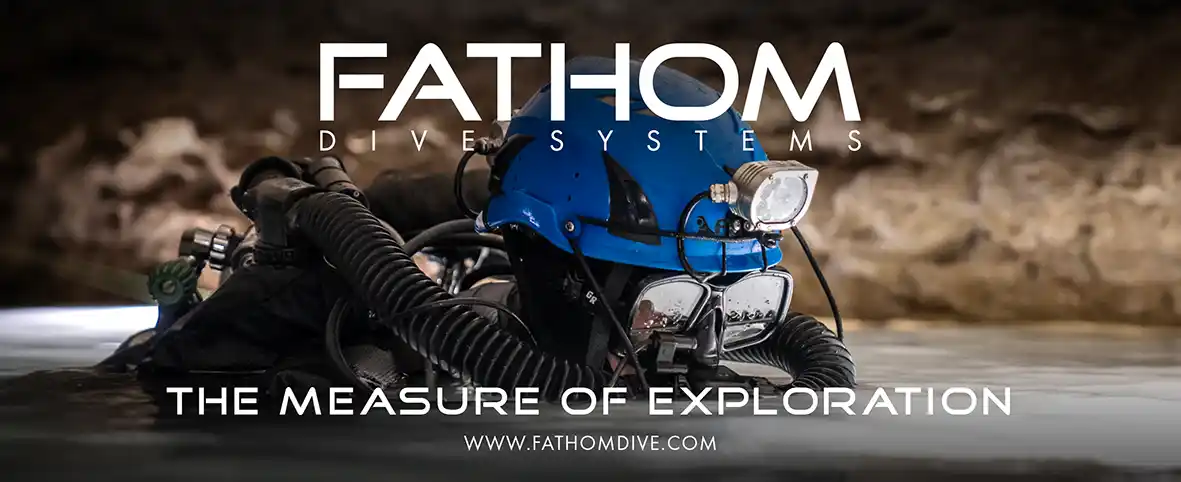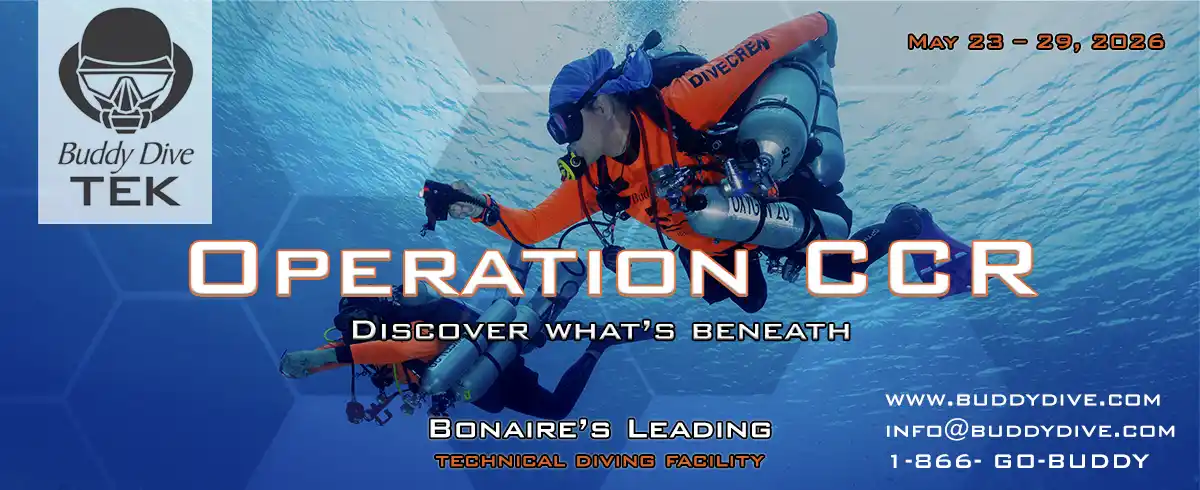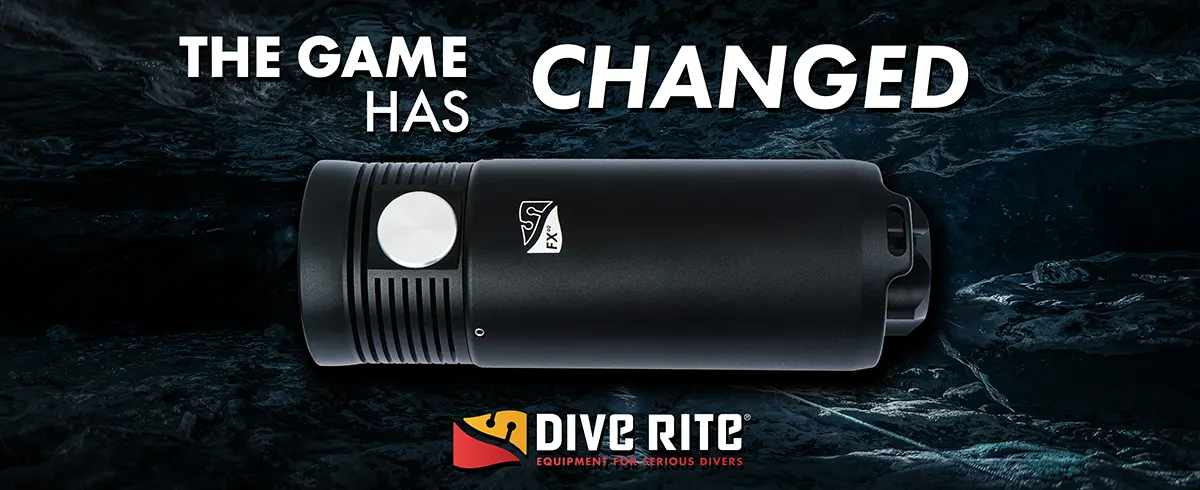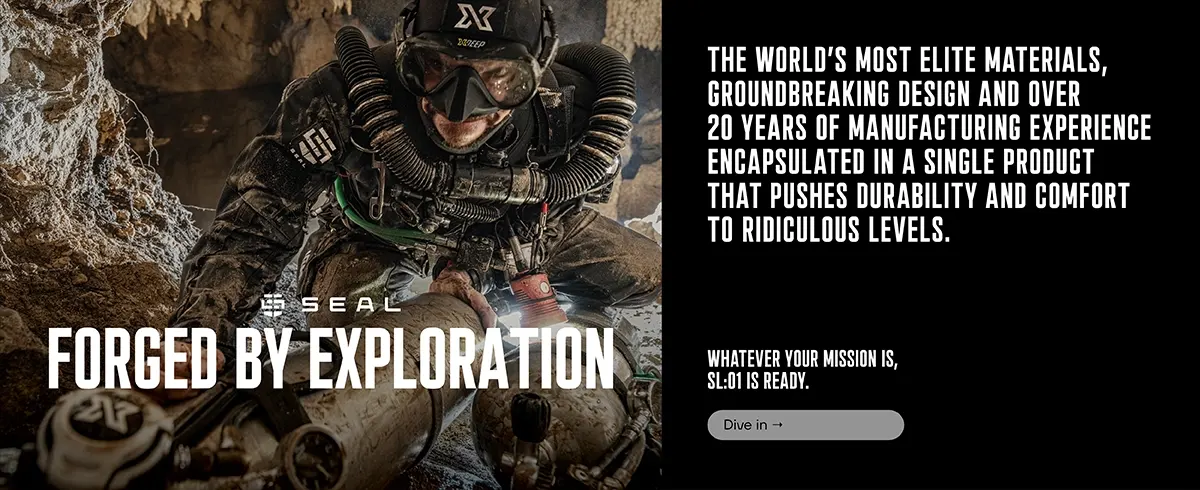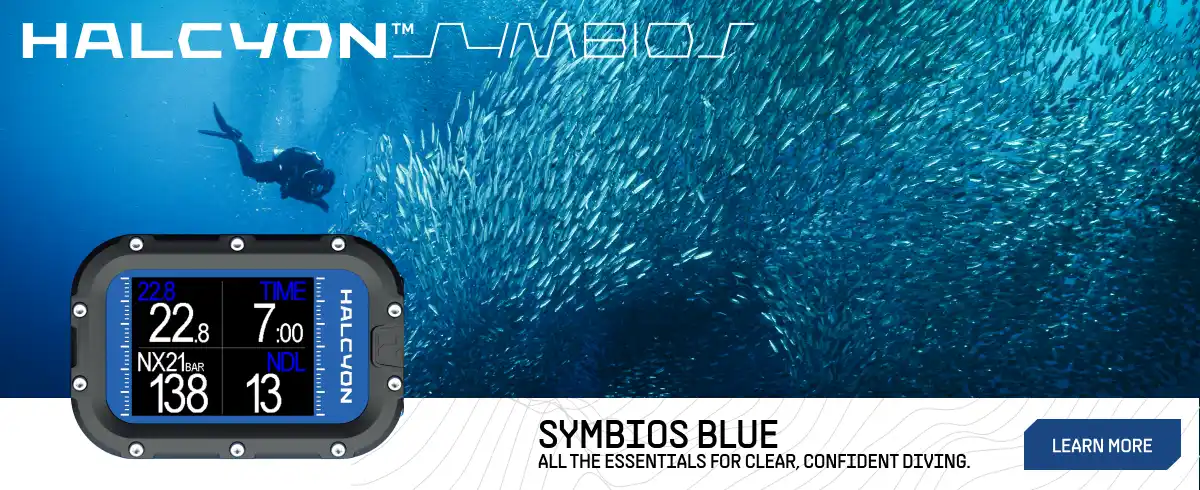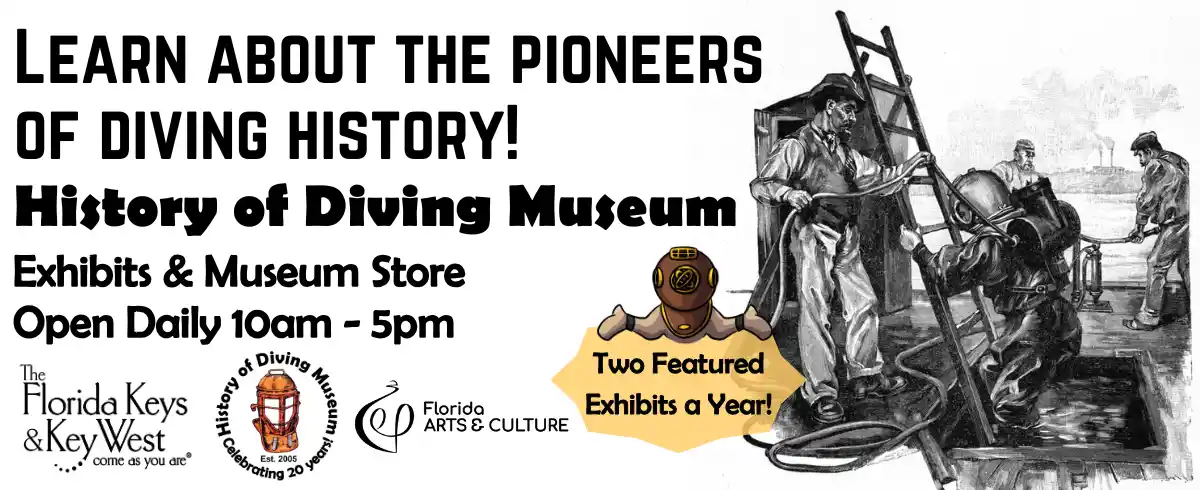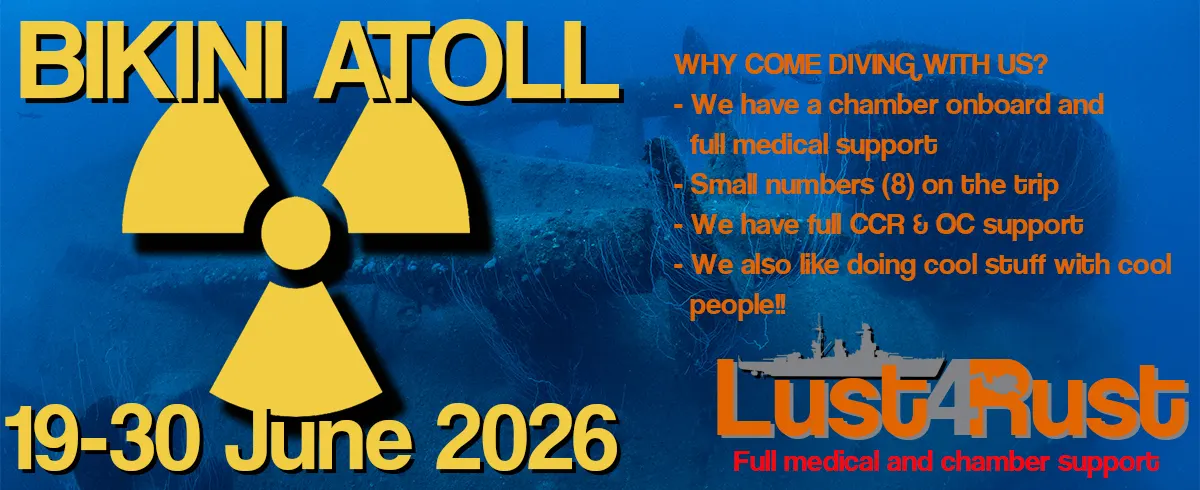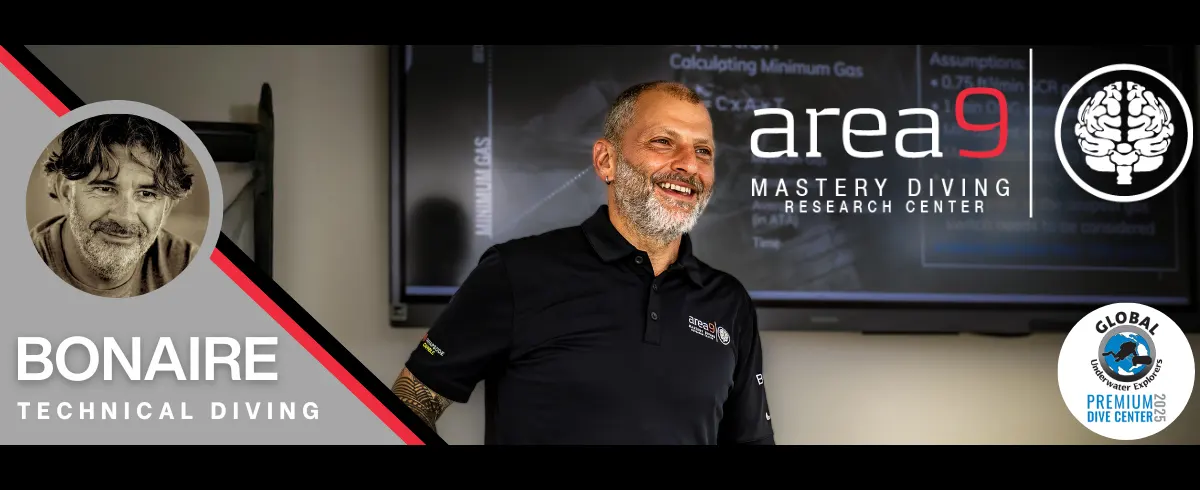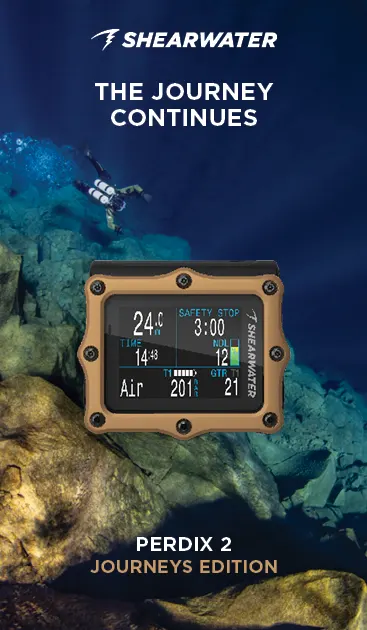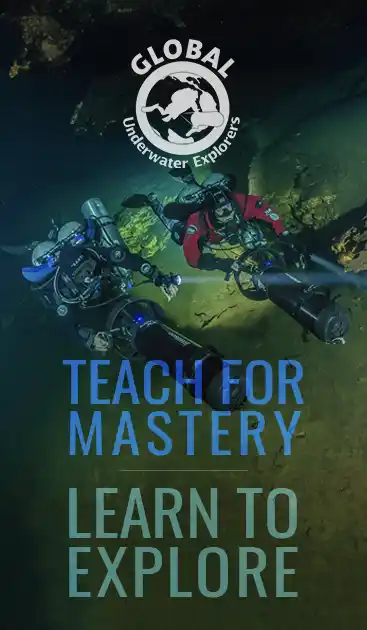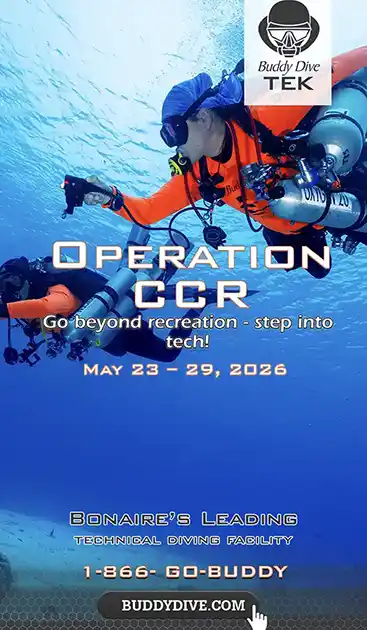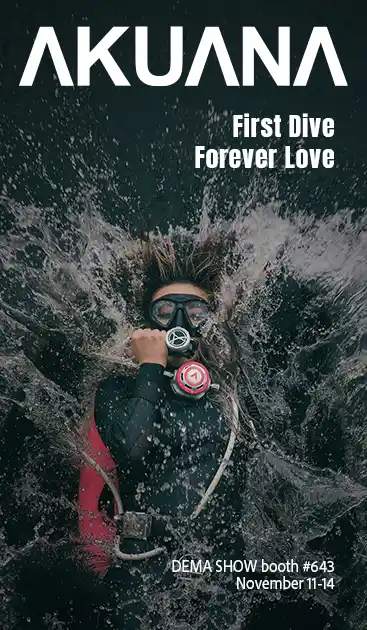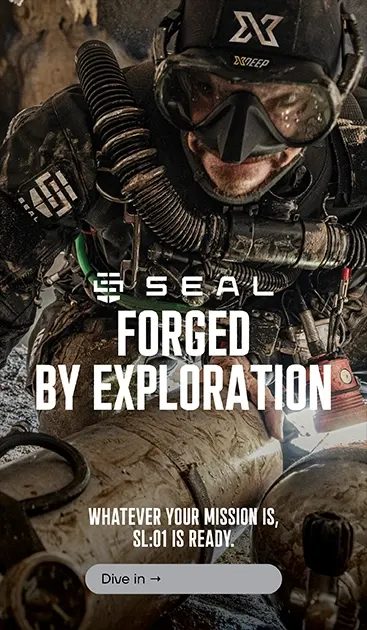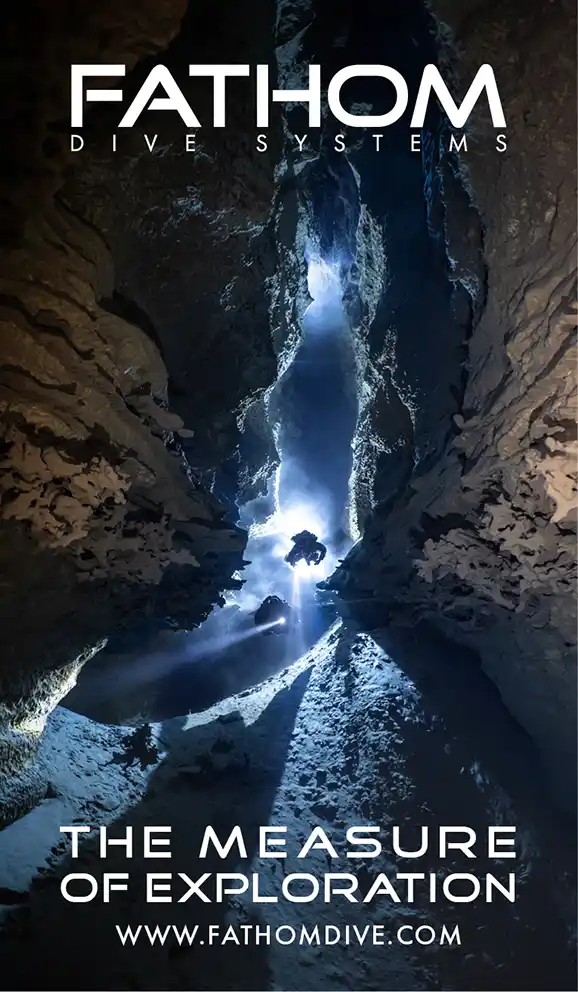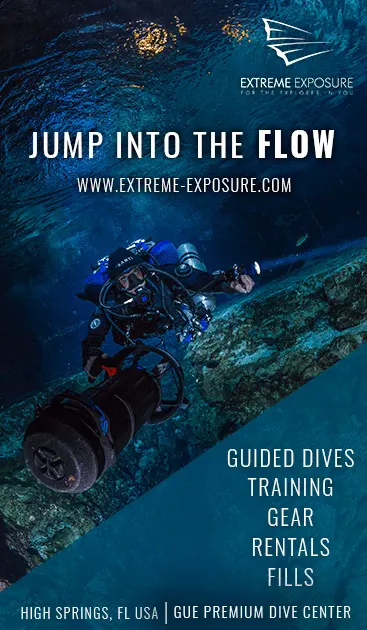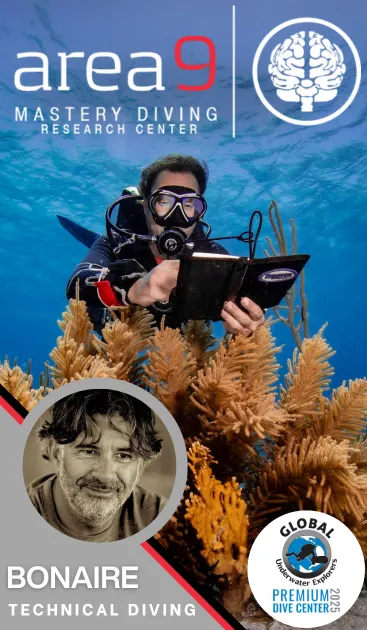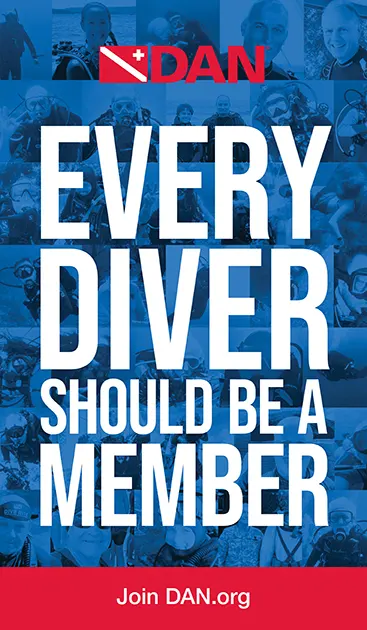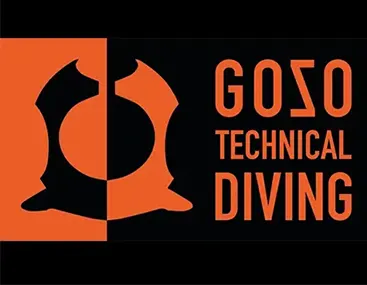Uncategorized
To Mix or Not To Mix? That is the Freediving Question!
A brief history of technical freediving, its advantages and disadvantages, training, and its future
By Kirk Krack, Founder and former President Performance Freediving International and Human Performance Diver Lead at DEEP. Images courtesy of the author and Nic Fazah unless noted.

My History of Technical Freediving and Developing Protocols
My involvement in the development of technical freediving has its foundations rooted in the early 1990s. At the time, I was a full-time mixed-gas scuba diving instructor trainer and an occasional freediver. I began to contemplate the time, depth implications, and advantages that freedivers could harness.
In 1998—while working in the Cayman Islands at my second dive business, Dive Tech—I was working with freediver Tanya Streeter. It was here where I had my first real experience with oxygen in breath-hold diving. I was using the remnants of an 80% decompression mix on the boat for recovery while waiting for my deep scuba safety team to finish decompression. I then jumped into the water to check on them and discovered that I had an incredibly long and comfortable breath-hold. From there, the idea began to take shape—initially focusing on the use of oxygen as a recovery gas and its time-related advantages. This would eventually evolve into using varying Nitrox mixtures for specific benefits and, finally, into the use of multiple Nitrox or oxygen mixtures in combination.
This almost-three-decade evolution eventually led to the application of these methods for safety divers at competitions, on movie sets with A-list actors and directors, on scientific expeditions plus the authoring of several technical papers along with the development of a “Technical Freediving” curriculum under my company, Performance Freediving International (PFI). Interestingly, the term “technical freediving” was an homage to Michael Menduo, founder and editor of aquaCORPS; he coined the term “technical diving” to describe what recreational decompression and mixed gas scuba divers were doing in the early 90’s—right when I was also a mixed gas scuba diver playing in the 170 m/558 ft depth zone of the Cayman Islands. It seemed a fitting way to describe breath-hold using varying oxygen mixtures, and I started using a variation of the term myself.
In January 2000, I founded Performance Freediving International (PFI). PFI offered one of the world’s first fully developed, multilevel educational systems for freediving and breath-hold training with standards and procedures along with recreational and professional materials; we were also the first to secure professional liability insurance. Although PFI started with entry-level recreational and professional programs, our vision always included specialty programs—such as harvesting, Diver Propulsion Vehicle (DPV) use, and oxygen-assisted training—which would later be formalized into what became known as “Technical Freediving.”

In 2001, I first introduced the use of surface oxygen (O₂) for my freediving athletes to help mitigate the risk of decompression illness (DCI) and to aid in recovery following deep freedives. One of the earliest realizations was that a significant portion of freedivers weren’t scuba divers, so using surface oxygen would reduce the risk of breath-hold related barotrauma while on scuba. Another immediate point was understanding the risk of someone using oxygen immediately before a deep freedive—which could lead to oxygen toxicity. I consulted Dr. Ralph Potkin, a hyperbaric physician and friend, to determine how long someone should be off of oxygen before diving again to allow their lungs to return to normal air levels. He determined that five minutes would be sufficient. Dr. Potkin would also go on to develop a self-contained bag with float, first stage, and three second stage regulators with 3 m/10 ft hoses for use with 100% oxygen for scuba divers as a precautionary safety stop gas; he called this system the “safe-d-stop.” We eventually used this as our first “system” for the same application but with breath-hold.
Thus, our initial protocol was established: five minutes on surface oxygen followed by a five-minute air break. From 2001 onward, this protocol was implemented across various world record events and PFI competitions. However, the idea to use mixtures other than oxygen was still percolating.
O2 Beyond Freediving
In 2006 and 2008, I worked with New York magician David Blaine for two events. One was “Drowned Alive,” a two-hour live TV special where, after seven days submerged in a 2.4 m/8 ft diameter acrylic sphere on scuba, he attempted to break the breath-hold world record while simultaneously trying to escape eight sets of handcuffs. The show lived up to its name; at just shy of seven and a half minutes, he was extracted by Mandy Krack and Martin Stepanek when blacking out.
Later, in 2008, while live on the Oprah Winfrey Show, David attempted to break the Guiness World Record using oxygen. After a 23 minute breath-up and under the safety and supervision of myself and partner Mandy Krack—while Dr. Potkin sat beside Oprah providing a medical analysis for her and the public—David achieved a time of 17:04 and a new Guiness World Record. However, an ECG that was hooked up to record his heart rate showed erratic heart beats toward the end of the performance and, during this and the preceding training, we saw the potential effects of CO2 narcosis firsthand. Oxygen can dull the chemoreceptors that sense the rise of CO2; as a result, a person can achieve incredible CO2 blood saturation levels while still having little urge to breathe. This can cause prolonged shakes, tremors, and an erratic heart rate after the breath-hold, and these effects can sometimes be felt for hours afterward.
Additionally, we realized that David was losing almost three or more liters of his lung volume through metabolization; and, while he initially started in a buoyant state requiring foot straps to keep him underwater and vertical, he would become negative towards the end, just like he might on an FRC or exhalation dive. Freedivers have also reported this sensation in their ears while breathing O2 for extended periods: The middle ear volume reduces, and freedivers must equalize without changing depth.
In June 2010, I experienced the first real-world application of technical freediving—more specifically, using gas repetitively during surface intervals. A team of PFI instructors and I were working on a fun video project called “Defending the Vandenberg.” We used surface oxygen for recovery and safety via the “safe-d-stop” system. Here, we also used oxygen to aid in accelerating surface intervals for the first time.
With some assistance from scooters, we towed the surface float equipped with oxygen and used it between freedives while filming around a wreck. We experimented with surface interval acceleration by reducing them by 50%: a method I had previously used as a technical diver. Before customized decompression tables became standard, technical scuba divers using air tables with 80% Nitrox or more could reduce those stops times by half. During this project, key PFI instructors including Mandy Krack, Erin Magee (Bricker), Ren and Ashely Chapman, and Ted Harty adapted this principle during the project successfully.
Little did I know that “Defending the Vandenberg” would eventually be seen by James Cameron, sparking ideas around underwater movements for scenes in “Avatar: The Way of Water.” That connection led to my eventual involvement in the film: I trained the cast and implemented technical freediving protocols.
In 2012, I used protocols like these to conduct three 100 m/330 ft freedives with only 20-minute surface intervals using oxygen. Using a DPV provided by DiveXtras, I descended and ascended down the deep wall near the Turtle Farm on Grand Cayman; a team of rebreather divers were stationed to assist if required. Within 30 seconds of surfacing, I completed a recovery breathing protocol. Then, I descended to 5 m/16 ft while breathing oxygen for the next 10 minutes, ascended, breathed surface air for another 5 minutes (while debriefing and briefing my safety freedive team), completed a self-assessment, and then spent a focused 5 minutes on snorkel preparing for the next 100-meter dive.
Although this approach was successful, it was not without risk. On another occasion in January of 2020, when pushing the boundaries of these protocols, I suffered a neurological DCI hit requiring decompression therapy. More about this later.
Tech Freediving in Comps
From 2014 onward, technical freediving protocols were increasingly used not just by athletes for recovery but also by safety freedivers and deep scooter divers. Years prior, we had already introduced the concept of “deep scooter safety freedivers” who would follow athletes to two-thirds of their target depth, ready to intervene if needed. We complemented this approach by positioning deep rebreather safety divers at or near maximum depth and by having primary and secondary safety freedivers meet athletes during the ascent phase at one-third depth.




My primary and secondary safety freedivers began using 32% Nitrox to a maximum depth of 40 m/131 ft prior to their freedives. This mix offered them a time and comfort advantage during recovery, though it didn’t shorten surface intervals. Overwhelmingly, the safety freedivers who had years of experience at Deja Blue competitions noted the decreased fatigue at the end of the day over the course of the three weeks of the competition compared to previous years on air. Deja Blue was a unique, three-week event; each week, participants completed five ocean sessions and five pool sessions. Each ocean session started at 6 am with a full set-up of the floating comp rig: an assortment of 11 different comp, warm-up, and scuba safety lines each with 10-15 kg/22-33 lb of weight at the bottom.

We, of course, had to break it all down at the end of the day. After we set up the rig, we started warm-up freedives, and then ran a safety scenario practice. By 8 am, the first of 25+ athletes showed up for their warm-ups and competition freedives. This meant that, each day, the average safety freediver easily completed 50-75 freedives (sometimes closer to 100 freedives) into the 40 m/131 ft range. All the while, the deep scooter safety freedivers required reduced surface intervals due to the depth of the freedives: sometimes reaching 80 m/262 ft but mostly in the 60 m/200 ft range. They would use 80% Nitrox immediately after diving to aid recovery and accelerate their surface intervals, switching back to their snorkels and air two minutes before diving again.
At the same time, athletes were encouraged to take a supervised, five-minute “complementary oxygen break” on the surface followed by a five-minute air break before continuing with training dives.
Tech Freediving on the Silver Screen
By the end of 2014, Hollywood came knocking. I was invited to consult on “Mission: Impossible – Rogue Nation” and to train Tom Cruise and Rebecca Ferguson at the Leavesdon, Warner Bros. studio outside London. Tom envisioned a long, continuous underwater scene without cuts—an idea sparked by his previous underwater experience in “Edge of Tomorrow.”

In addition to standard breath-hold fundamentals taught in classrooms, workshops, and water sessions, I introduced the use of 50% Nitrox. This mixture helped eliminate hypoxic concerns, sped up recovery, and allowed for longer, more comfortable breath-holds. The idea, however, faced resistance from the marine safety team who preferred using compressed air at depth followed by breath-holding.
After thorough consideration and a consultation with a hyperbaric physician, I made my case: A breath-hold on 50% Nitrox from the surface was significantly safer than using compressed air at depth before a subsequent breath-hold, which could pose a risk of lung expansion injuries. I emphasized that even pure oxygen would be safer, as any embolism would at least be metabolized. The argument was persuasive—50% Nitrox was approved as was breath-hold from the surface.
During training, Tom and Rebecca performed exceptionally well. Tom achieved 40 m/131 ft constant ballast freedives in the Cayman Islands and managed a comfortable breath-hold of over six minutes during training on air. I had no idea this was just the beginning of my career training actors for underwater film work.
In June 2015, I joined another film project—”Suicide Squad,” shot in Toronto. I was brought on to train Margot Robbie for an underwater scene: Her character, Harley Quinn, would be submerged in a car before Batman rescued her. Additionally, I trained her stunt double, Ingrid Kleinig, who also rehearsed extensively with me. Once again, I utilized 50% Nitrox to mitigate hypoxic risk.

During this shoot, I was asked to double as Batman for the underwater sequence (which my daughter, Kaila, thought was the coolest thing). It was here I reunited with Pete Zuccarini, the underwater Director of Photography. Pete and I had first worked together in the late ’90s in the Cayman Islands while filming a commercial. We would meet again on “Avatar,” where we both utilized our fair share of Nitrox mixes. Pete would go on to recently place Second in the Masters Division at the CMAS Indoor World Championships in Greece with a static breath-hold time of 6:32 on air.
Expedition Technical Scooter Freediving


Eventually, the idea of technical freediving in an expeditionary setting—specifically Chuuk (Truk Lagoon)—would be realized in January 2017. I traveled to Chuuk along with PFI instructors John Hullverson and Chris Bustad for a weeklong liveaboard trip; the remaining complement of guests were rebreather divers hosted by Bill Coltart, head of deep rebreather scuba safety at PFI Deja Blue competitions. It was here where we really set about solidifying the protocols around “Expedition Technical Scooter Freediving.” While on this trip, I would also meet the boat’s technical scuba instructor, Aron Arngrimsson, who, the following year, would form The Dirty Dozen Expeditions. During this expedition, we refined three major protocol advancements:
- Use of multi-mix gases – Including designated post-dive (“high mix”) and pre-dive (“low mix”) mixtures
- A revised surface interval protocol – Moving from the older Batle Table (Developed by Dr. John Batle, University of Balearic Islands, Spain) to what we named the “Krack Multiplication Factor”
- Refined “air break” protocols – To safely transition from high oxygen partial pressures back to air


We typically used 32% and 80% Nitrox during the same session; although, on deeper wrecks in the 70 m/230 ft range, we used air. Ascending from a breath-hold dive, we would immediately switch to our “high-mix” of 80%, calculate our surface interval with reduction, then after a prescribed period, switch to our “low-mix” or our bottom gas for our last several minutes of breathing and last breath. We had to adapt proper gas-switching procedures for freediving to avoid mix errors—just like technical scuba divers do. For instance, using a high mix too deep risks CNS oxygen toxicity; using a low mix at the wrong time might negate surface interval acceleration and increase risk of DCI.
Over the course of the trip, the Krack Multiplication Factor with acceleration due to 80% enabled us to reduce surface intervals by up to 40%, resulting in more dives, longer bottom times, and better safety margins. To refine our “air break” timing, we even conducted an experiment using oxygen analyzers and plastic bags, testing 5-, 4-, 3-, and 2-minute air breaks after breathing oxygen for 5 minutes. The results confirmed that 2 minutes was the shortest safe break before returning to air or to a low mix from a high mix.

It was during this expedition that I received an email from Tim Buhlman, a friend who had worked with James Cameron on “Challenger Deep.” The message read:
“Kirk, answer your phone—James Cameron is trying to call you about the next Avatars…”
What better excuse for missing his call than:
“Sorry, I’m currently technical scooter freediving Truk Lagoon.”
I knew Jim would understand.
Technical scooter freediving Chuuk would prove extremely successful and a fun, grand expedition adventure with key learning achieved. We would try to book again within the next couple of years for another larger trip, but it would have to wait—a monumental, career-changing opportunity was just around the corner.
Returning James Cameron’s Call
By May 2017, technical freediving would reach its most expansive and high-profile application—James Cameron’s blockbuster, “Avatar: The Way of Water.” Not long after returning from Chuuk, I found myself in Cameron’s dining room in Malibu, listening to his ambitious plans for four “Avatar” sequels. The water-centric first sequel posed a unique challenge: how to film underwater performance capture without scuba. Bubbles from exhalation disrupted the motion capture system’s ability to track the reflective markers on the suits.

Jim asked what I thought and I told him plainly: Train everyone—not just the Metkayina “water Na’vi” actors, but also the stunt team, camera operators, grips, everyone—to shoot entirely on breath-hold, and apply what I had developed as “technical freediving.” He replied that they’d been wondering if the use of oxygen on this scale was even feasible, and I assured him that it was not only feasible and would work, but that I had developed and tested working protocols for it. While travelling back to my hotel, I was informed that the job was mine should I want it. This would be one of the biggest opportunities for me and my career.

Over the next 2.5 years in Los Angeles, we applied technical freediving on an unprecedented scale. Using both 50% and 80% Nitrox, we logged over a quarter-million technical freedives. We went through more than 1,500 80-cubic-foot cylinders of Nitrox. Our largest scene had 26 people underwater at once, all on breath-hold, with no hypoxic incidents.
We opted for 80% Nitrox instead of pure oxygen for two key reasons:
- The stage tank featured a deep well that extended to 10 m/33 ft, where oxygen partial pressures could potentially be unsafe over continued extended quick repetitive times.
- The use of Nitrox helped us manage oxygen consumption more efficiently over long shoot days.
These protocols were also carried forward into the third film, “Avatar: Fire and Ash” which was being shot concurrently. We also took these protocols to New Zealand where we used live capture (non-dotted suits) to record performance in real underwater environments.

It should be noted that the actors I worked with aged in range from six to sixty-nine years of age and had varying water experience levels. One of the cast, who was a Metkayina, initially had a strong dislike of and apprehension about the water. It was also during this shoot that Kate Winslet recorded a static in-water breath-hold on 50% for 7:14. An amazing crew of stunt performers and safeties were trained, and several went on to become PFI instructors themselves. John Garvin was head of the Avatar marine unit, and he became a great friend. John was initially tasked by James Cameron to investigate and ensure that the protocols I was proposing were above board, and I was able to help him successfully cross all hurdles presented by using oxygenated mixtures.
With proper training and protocol implementation, technical freediving proved not only effective but extraordinarily safe—even at industrial scales. It was the most extensive real-world use of the methodology to date.
When Risk Becomes Reality
January of 2020, just before the world went into COVID lockdown, I encountered a setback: a type II neurological decompression hit. After spending two and a half years in a 5-10 m/16-33 ft water tank on Avatar full-time, I wanted to get back to some depth. I had always been able to teach PFI Advanced Freediver level programs following athletes into the 60 m/200 ft range—the max depth of that program—and, at this point, I was feeling like that ability had slightly diminished after so long shallow. My marathon capability to complete 4-minute breath-holds constantly across 12-16 hour workdays was amazing, but depth felt compromised.
So, John Hullverson and I went to the Cayman Islands for a week of training where the focus was on me. Only once previously had I ever had a week where I wasn’t coaching, setting up equipment, or being a safety for others; this was a precious opportunity. Unfortunately, during the week, a constant scrub of training sessions occurred—I was losing my opportunities. My growing frustration at this precious week slipping away only grew until the last day. On our last day, once again, depth line diving would be scrubbed, and the worst of me took over. I grabbed a scooter, determined to make something of this wasted week. I started some depth compression training using the scooter and using 80% mix to recover and accelerate. John was leaving the island that afternoon. Technically, I did everything properly—just to the max. However, in hindsight, I realized that I wasn’t “slowing” my shallow depths on the scooter as much as I should have been. After several repeated depth scooter freedives, with one hitting 100 m/330 ft, we pulled up line and moved our way along to getting John to his flight.
Several hours after dropping John off at the airport, I had a seizure around the pool deck. I came to on the couch of my condo with my good friend Duncan Heard saying, “Kirk, you need to breathe this,” while he held a non-rebreather mask of oxygen out to me. I fought him on the mask at first, but I quickly realized what was happening and started breathing it. An ambulance arrived, and I was taken to the hospital where I underwent hyperbaric oxygen therapy—but only after the intervention of some of the world’s most respected hyperbaric authorities. These experts advocated on my behalf; the hospital insisted that a chamber treatment wasn’t going to be in the cards because “You can’t get bent freediving.”
The next six months, I would describe myself as feeling grey: no emotions of happy, sad, and so on. It was also hard to reconcile my recovery as we were now in the full swing of the world shutting down because of a pandemic. I’ve since made a full recovery with no aftereffects and, by the fall of 2020, I was again in New Zealand on Avatar spending 75 hours a week in-water using 50% and 80% oxygen in 5m of depth—great additional HBO therapy. Lesson learned. Scooters and freediving are amazing fun; however, ascent rates need to be followed, conservatism and a cool head are your friend, and more research and testing need to be done. Not my proudest moment upon self-reflection: But live, learn and share it with others.
Tech Expeditioning
In March 2025, we returned to Chuuk for the “Chuuk Technical Scooter Freediving Research Expedition,” aiming to further innovate technical freediving in a research setting. This time, six PFI instructors—all trained in technical freediving—participated: myself, John Hullverson, Willow Wise, Nate Leazer, Jessea Lu, and Nick Fazah. DAN researcher Sherri Ferguson was our research lead and joined us to collect data.

Each diver had their own personal freediving equipment, plus customized Shearwater Teric computers designed to record our gas switches and to track our gas consumption. We each brought customized DPVs with Dive Xtras supporting us with their CudaX models that were kitted with front- and back-facing mounted GoPros.

The team shared two tow floats constructed by Gannet based on my design. Each float carried two 12 L/80 cuft scuba bottles of Nitrox; each of the four tanks had an oxygen-serviced first stage regulator, two 2 m/6.5 ft long-hose regulators, and one 10 m/33 ft long hose second stage regulator. The extra-long hose second stage regulator was to assist us should we need to engage in ‘Freediving In-Water Recompression’ protocols. These protocols were previously designed with the assistance of Dr. Peter Lindholm based on a modified technical scuba model protocol of In-Water Recompression by Mauritius Bell, diving safety officers of the California Academy of Underwater Sciences, and a PFI Instructor. While diving, we operated in teams of three completing two 2.5 hour sessions per day over seven days.




Before and after diving, we conducted:
- Pre-dive baselines (cardiac and lung function)
- Post-dive 2D echocardiograms
- Lung function and cognitive testing
- Pulse oximetry
- Wellness questionnaires
Each 2.5-hour ocean session could feature a controlled protocol combining some of the following:
- Air-only dives
- High-mix with no acceleration
- Low-mix only (non-air)
- High- and low-mix combined
- High-mix 80% with surface interval acceleration
- Low-mix with Equivalent Air Depth (EAD) consideration
- High- and low-mix with both EAD and interval acceleration

We also continued to use the Krack Multiplication Factor (KMF) protocol to calculate optimized surface intervals.

The expedition was completed incident-free with scooter freedives as deep as 70 m/230 ft range, but mostly in the 30-50 m/100-164 ft range. We collected valuable data and stunning footage. Notably, one diver consistently showed several dives with bubbles when diving air only, detected by the 2D Echocardiogram recorded by Sherri and confirmed by Dr. Virginie Papadopoulou of Divers Alert Network. The results appear promising enough to warrant a whitepaper and potentially a more extensive follow-up study in the future.

The Future of Technical Freediving
The future of technical freediving is bright. As it becomes more accepted, its value as a specialized tool for specific missions will grow. Recreational freedivers enjoying shallow reef dives may not find it practical; but, for working freedivers, filmmakers, spearfishers, and explorers, it’s a powerful addition to their skillset.
In competitive freediving, technical freediving should become a standard for safety freedivers, especially for:
- High-repetition or deep scooter dives
- Reducing surface intervals and ensuring quick turnarounds
- Extending safety breath-holds in case of a delayed athletes
At PFI Deja Blue competitions since 2001, athletes have been encouraged to use a supervised 5-minute surface oxygen recovery break, followed by a 5-minute air break prior to further dives.
As for post-dive decompression stops at 6 m using pure oxygen: I view these as carrying more risk than benefit unless managed by trained technical freedivers with scuba knowledge and strict supervision. Surface oxygen is safer and more practical in most cases, so I’d like to see the sport organizers put more thought into this practice from a safety point of view.
Freediving computers should first start using proper, tested surface interval protocols. Besides our surface intervals timer, we need a surface interval countdown time showing us when the next freedive can be started based on the previous dive. Additionally, a technical freedive protocol could allow us to program surface mixes and adjust corresponding surface interval countdown timers while also tracking oxygen exposure and providing partial pressures.
Already, on air, we achieve world records with fins of over 130 m/427 ft or 14 ATA. Assuming, due to metabolization, that a freediver at this depth has 16% in their lungs (likely still higher), it would have freedivers already running PO2’s over 2.2 ATA of oxygen. The average depth at any world championship has freedivers over 1.6 ATA of oxygen pressure. I would be interested to know what relationship the time/dose response of oxygen partial pressures have on freedivers especially when we have predisposing factors such as CO2 rise and exertion.
While there will always be skeptics and traditionalists, technical freediving is following the same path as technical scuba did in the 1990s. With proper protocols and training, it opens new frontiers in freediving that are safer, more efficient, and full of potential—and technical freediving, of course, allows many of us the chance to nerd out.
Return to: Technical Freediving is Re-emerging as the Cutting Edge of Diving
DIVER DEEPER
Deeperblue: Technical Freediving: Are Freedivers Ready to Mix it Up by Michael Menduno
JHPEE: Covington D, Lee, RH, Toffell S, Bursian A, Krack K, and Giordano C Technical Freediving: An Emerging Breath-Hold Diving Technique, Journal of Human Performance in Extreme Environments: Vol. 15: Iss. 1, Article 3 2019 DOI: 10.7771/2327-2937.1122
DIVER: Kirk Krack: Writing The Book on Freediving by Michael Menduno
Dirty Dozen: Episode #9: Kirk Krack; Technical Freediving in Hollywood with Aron Arngrimsson

Kirk Krack is a leader in the field of diving, with over three and a half decades of experience. A multi-disciplined diver, he began his professional diving career in 1988 in Canada. By the mid-1990s, he had specialized in mixed-gas technical diving, operating at depths up to 170m (550ft), and ran a successful diving business in the Cayman Islands.
In January 2000, Kirk founded Performance Freediving International (PFI), creating the world’s first comprehensive instructional system for freediving. Through PFI, he trained seven athletes to achieve a combined 23 world records. He also developed the Advanced Freediving Research Program at Simon Fraser University and co-authored multiple scientific papers. Kirk pioneered Technical Freediving, introducing innovative protocols that utilize varying oxygenated gas mixtures.
As an innovator, Kirk developed the first Breath-Hold Survival Program, which later evolved into Breath-Hold Special Operations—a program currently used by nine different special operations groups across three countries. He was awarded the DAN Rolex Diver of the Year in 2016 for his contributions to freedving safety.
Kirk also serves as a Performance Advisor with Liminal Collective, a global leader in human performance, working with corporations, elite teams, and athletes. His expertise has extended to the film industry: he was part of the Academy Award-winning team for the documentaries The Cove and Racing Extinction, produced by the Oceanic Preservation Society (OPS). He also trained Tom Cruise and Rebecca Ferguson for Mission Impossible: Rogue Nation, Margot Robbie forSuicide Squad, and was personally selected by James Cameron to train the cast and crew of Avatar: The Way of Water.
Currently, Kirk works with DEEP Research Labs and the DEEP Institute as Human Performance Diver Lead, focusing on developing the concept of the “multi-disciplined human performance diver.” In addition to this role, he contributes to business development and strategic relations.


